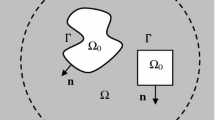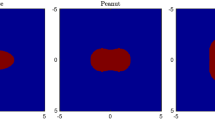Abstract
A nonlinear optimization method was developed to solve the inverse problem of determining the shape of a hard target from the knowlegde of the far-field pattern of the acoustic scattering wave, it was achieved by solving independently an ill-posed linear system and a well-posed minimization problem. Such a separate numerical treatment for the illposedness and nonlinearity of the inverse problem makes the numerical implementation of the proposed method very easy and fast since there only involves the solution of a small scale minimization problem with one unknown function in the nonlinear optimization step for determining the shape of the sound-hard obstacle. Another particular feature of the method is that it can reproduce the shape of an unknown hard target efficiently from the knowledge of only one Fourier coefficient of the far-field pattern. Moreover, a two-step adaptive iteration algorithm was presented to implement numerically the nonlinear optimization scheme. Numerical experiments for several two-dimensional sound-hard scatterers having a variety of shapes provide an independent verification of the effectiveness and practicality of the inversion scheme.
Similar content being viewed by others
References
Colton D, Kress R.Inverse Acoustic and Electromagnetic Scattering Theory[M]. Berlin: Springer, 1992.
Colton D, Monk P. A novel method for solving inverse scattering problem for time-harmonic acoustic waves in the resonance region II [J].SIAM Appl Math, 1986,46(3):506–523.
Colton D, Monk P. The numerical solution of the three-dimensional inverse scattering problem for time harmonic acoustic waves[J].SIAM J Sci Comput, 1987,8(3):278–291.
Kress R, Zinn A. On the numerical solution of the three-dimensional inverse obstacle scattering problem[J].J Comput Appl Math, 1992,42:49–61.
Angell T S, Kleinman R E, Kok B,et al. A constructive method for identification of an impenetrable scatterer[J].Wave Motion, 1989,11:185–200.
Jones D S, Mao X Q. Inverse problems in hard acoustic scattering[J].Inverse Problems, 1989,5: 731–748.
Murch R D, Tan D C H, Wall D J N. Newton-Kantorovich method applied to two-dimensional inverse scattering for an exterior Helmholtz problem[J].Inverse Problems, 1988,4:1117–1128.
Kirsch A. The domain derivative and two applications in inverse scattering theory[J].Inverse Problems, 1993,9:81–96.
Mönch L A. A Newton method for solving the inverse scattering problem for a sound-hard obstacle [J].Inverse Problems, 1996,12:309–323.
Hohag T. Logarithmic convergence rates of the iteratively regularized Gauss-Newton method for an inverse potential and inverse scattering problem[J].Inverse Problems, 1997,13:1279–1299.
Oches J R. The limited aperture problem of inverse acoustic scattering: Dirichlet boundary conditions[J].SIAM J Appl Math, 1987,47(6):1320–1341.
Zinn A. On an optimization method for the full-and limited-aperture problem in inverse acoustic scattering for a sound-soft obstacle[J].Inverse Problems, 1989,5:239–253.
Couchman L S. Inverse Neumann obstacle problem[J].J Acoust Soc Am, 1998,104(5):2615–2621.
Kress R, Rundell W. Inverse obstacle scattering using reduced data[J].SIAM J Appl Math, 1999,59(2):442–454.
You Y X, Miao G P, Liu Y Z. A fast method for acoustic imaging of multiple three-dimensional objects [J].J Acoust Soc Am, 2000,108(1):31–37.
You Y X, Miao G P, Liu Y Z. A simple method for visualizing multiple three-dimensional objects from near-field data with point source excitation[J].Acta Acustica, 2001,87(1):1–10.
You Y X, Miao G P, Liu Y Z. A numerical method for solving the limited aperture problem in three-dimensional inverse obstacle scattering[J].International of Nonlinear Science and Numerical Simulation, 2001,2:29–42.
Miao G P, You Y X, Liu Y Z. A numerical method for the shape reconstruction problem in acoustic scattering[J].Inverse Problems in Engineering, 2000,8(3):229–249.
You Y X, Miao G P, Liu Y Z. A nonlinear optimization method for an inverse transmission problem [J].Inverse Problems, 2001,17:421–435.
Colton D, Monk P. On a class of integral equations of the first kind in inverse scattering theory[J].SIAM J Appl Math, 1993,53(3):847–860.
Reginska T. A regularization parameter in discrete ill-posed problems[J].SIAM J Sci Comput, 1996,17(3):740–749.
ZHAO Feng-xhi,Quadratic Approximation Method in Numerical Optimization[M]. Beijing: Science Press, 1994. (in Chinese)
Author information
Authors and Affiliations
Additional information
Communicated by Dupai Shi-qian
Foundation items: the Excellent Doctorial Paper Foundation of Education Ministry of China; the Shuguang Project of Shanghai Education Committee
Biography: Yupou Yun-xiang (1963 ∼)
Rights and permissions
About this article
Cite this article
Yun-xiang, Y., Guo-ping, M. Numerical method for the shape reconstruction of a hard target. Appl Math Mech 24, 1233–1244 (2003). https://doi.org/10.1007/BF02438112
Received:
Revised:
Issue Date:
DOI: https://doi.org/10.1007/BF02438112




